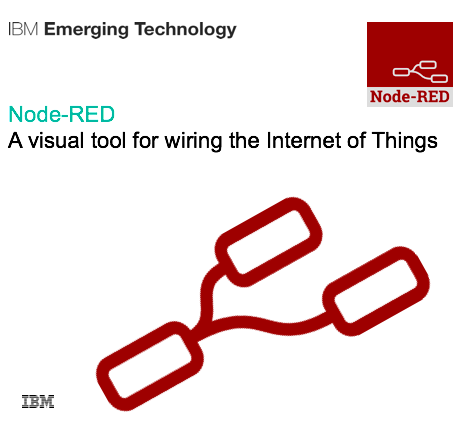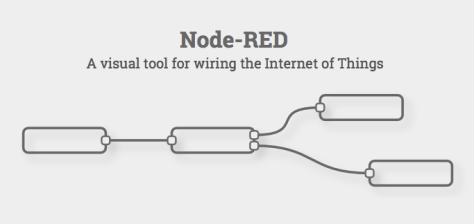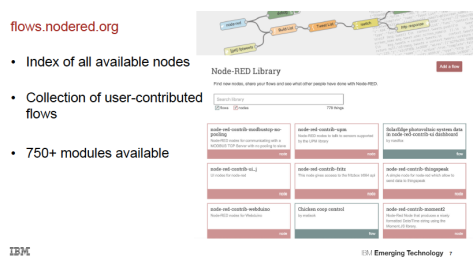IoT Innovation that matters – Node-RED

With 33+ years of Enterprise IT solutions and architectural experience, it’s not often that I come across innovations, ideas and solutions that are truly new and/or transformational.
However I have to say a recent IBM OpenWorks Node-RED webinar and IoT solution / device integration webinar really made me sit up and take note, the event replay can be found here.

In the webinar the team of presenters and founding Node-RED developers from IBM’s Hursley Development labs, Nick O’Leary and Dave Conway-Jones (IBM Senior Inventor), in conjunction with Dr Mike Blackstock and Dr Rodger Lea from Sense Tecnic Systems, Inc (and the University of British Columbia) really knocked it out of the park for me.
It looks like an excellent combination of a logical, simple, effective idea and combined with ease of use and flow execution. It combines a set of API driven device integrations and data inputs/outputs into “flows”, leveraging a flow based programming model, that in turn was originally defined by J. Paul Morrison at IBM in the early 1970’s.
Node-RED has now been adopted by Linux Foundation JavaScript js.foundation
This model essentially combines a network of asynchronous processes communicating by means of streams of structured data chunks or elements, where each process is in effect “a black box”. Each step does not not need to know what went before, or indeed what comes after: it just acts on the data it receives and passes the result on.
In this respect it is similar in concept to one of the founding principles of IBM’s MQSeries, deliver once reliably and only once, and/or subsequently MQTT as a lightweight pub / sub messaging protocol that sits behind Facebook chat etc.
Remembering childhood games of “pass the parcel” where participants could leave (or indeed re-join) the game, whilst executing their specific step until the music stopped.

The Node-RED solution (which has now been adopted and is being further developed by the Node.JS open source community) looks like a very elegant, cost effective and simple solution to complex IoT / Manufacturing 4.0 device and data integration requirements.
To me, I really enjoyed the IBM OpenWORKS talk and would commend it to IT Strategy teams and architects that are engaged in Front Office / IoT Digital Innovation solution deployments and platform strategy definitions.
You might also call this Node-RED solution the “yin” to a blockchain / IBM Hyperledger “yang”, where both are now founded on significant Open Source principles whilst one does not mind what went before and after, and the other executes principles of immutability in a trusted network of asset flows (fiscal or physical).

Also this week I really enjoyed the annual British Computing, Alan Turing lecture by Dr. Guru Banavar is vice president and chief science officer for cognitive computing at IBM.
Guru is responsible for advancing the next generation of cognitive technologies and solutions with IBM’s global scientific ecosystem, including academia, government agencies and other partners, he leads the team responsible for creating new AI technologies and systems in the family of IBM Watson, that are designed to augment (and not replace) human expertise in a broad range of industries.
For me it was an interesting and logical co-incidence that Guru was previously, the chief technology officer (CTO) for IBM’s Smarter Cities initiative, where Node-RED also has very logical use cases for building climate control systems and solutions, described by Dr Mike Lea and Dr Roger Blackstok in the second part of the Node-Red update.
Guru Banavar designed and implemented big data and analytics systems to help make cities, such as Rio de janeiro and New York, more livable and sustainable.
When I logically put together Node-RED IoT / Manufacturing 4.0 / IBM Watson IoT enabled innovation with IBM’s Bluemix Dev/Ops platform and the IBM Watson Cognitive, Analytical and HyperLedger capabilities in a secure Hybrid Cloud, API / Microservices enabled “Choice A” scenario the opportunity for Open Source enabled digital innovation seems to be truly significant!
The opinions within this blog are the authors, they do not represent a formal IBM corporate point of view.